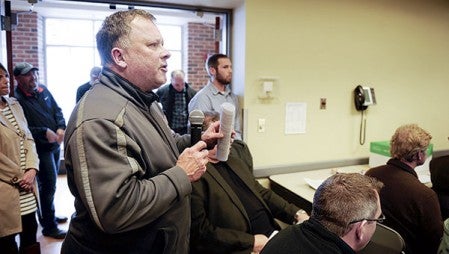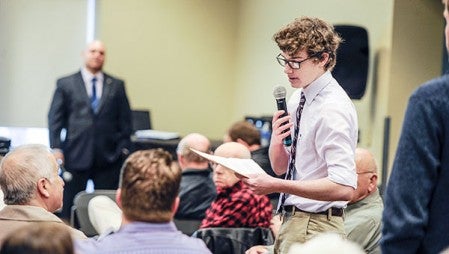Stirring opinions; Public raises questions at rec center forums
Published 10:13 am Wednesday, March 16, 2016

The main conference room of the Austin Public Library was filled for a forum on the Austin Community Recreation Center Tuesday. Photos by Eric Johnson/photodesk@austindailyherald.com
It was standing room only in Austin Public Library’s large meeting room as people young and old listened to arguments for and against plans to build the Austin Community Recreation Center at the downtown Austin Municipal Plant site.
Vision 2020 held two community forums Tuesday on the proposed $35 million rec center, which has been a heated issue since the Vision 2020 Community Rec Center Committee named the former Austin Utilities plant on Fourth Avenue Northeast its preferred site.
At the forums, many residents raised questions and concerns about parking, operations funding, preserving the plant building, membership costs, the YMCA’s involvement and management, and what the building might look like architecturally.
One woman voiced concerns that the plan doesn’t call for a true rec center, as it would feature only a small portion of public space adjoined to a new YMCA facility.
“The main concern is that we’re talking about a public community rec center, we don’t have a public community rec center,” resident Julie Everson said.
The public portion of the facility would likely include a youth activity center, a children’s play area, an aquatic center with a day rate for city residents, and more. The spaces would be available for a few different community events. Committee members would be open to hosting community events such as the Austin Artworks Festival, which has been hosted at the plant for a number of years, Matt Cano, co-chair of the Vision 2020 Rec Center Committee, said.
The facility could also include a walking/running track, gymnastics area and more as part of the new Y. However, some residents disagreed the Y should be involved in the new facility.
“If I want to use the pool, I join the Y or I pay a fee to the Y. If I want to use a track, I join the Y or pay a fee to the Y. I have no problems with the Y, there are people that love the Y, [but] let the Y build their Y wherever they want to,” Everson said. “I want a public recreation center that’s for the public, for the poor, for the kids, for the middle income, it’s for young families, it’s for us elderly that want a place to walk…I want a public community center, separate from the Y.”
However, Cano, said the facility would also serve at-risk youth with a youth activity center and serve parents of preschool age children. He said there would be an affordable day pass or memberships.
The next steps are to acquire city council approval, work with an architect on a more specific design and begin fundraising.
Location
The rec center committee started with a list of 30 locations that were eventually narrowed down to four, including the Austin Utilities plant site, an area east of the post office, the Wescott Athletic Complex area and land near Riverland Community College. The committee eventually came to the conclusion a downtown power plant location would be best.
“Those four were examined a little more thoroughly by our committee and we identified there was a need for a downtown location and that led us to … a place that people can get to easy,” Medgaarden said.
She added it was chosen because of its centralized location, connection to other facilities such as the library, Austin Municipal Pool and Mower County Senior Center, along with the availability of the plant site.
“There’s a lot of youth that need to be able to get to those facilities whether they’re walking or riding their bikes,” Medgaarden said.
Austin Utilities has been searching for a buyer since 2009, and the utilities board approved a purchase agreement with the city and Vision 2020 on March 8.

Don Leathers voices parking concerns if the rec center were to be built downtown at the Austin Utilities plant during a forum Tuesday at the Austin Public Library.
Eric Johnson/photodesk@austindailyherald.com
The other positive they considered was the plant is an empty building and they wanted to remove any liability it might become to rate payers, Medgaarden said.
Many residents questioned if there would be enough space to park once the facility was built. Medgaarden said they didn’t have the number for parking spaces yet because they hadn’t gone that far into the design process and didn’t want to spend the money until a site was acquired.
One resident mentioned it would be a great opportunity on Fourth Avenue and others said it would be nice for their kids to be able to go from the pool to the library and to the rec center without ever stepping onto a street.
However, others opposed the location because it means the plant building would be largely demolished. They asked if there was a way to incorporate some elements of the building into the rec center, such as the smoke stacks and lighted red sign.
Transparency
Quin Brunner, who has helped lead a push to preserve the plant, brought up the topic of a developer being involved with a $70,000 study from Gronen Restoration in Dubuque, Iowa. That was part of an initial Vision 2020 committee on the utilities building exploring turning the building into housing and commercial space and Brunner asked how it went from repurposing the building to demolishing it.
“How did 2020 go from actively pursuing the revitalization of the utilities building to promoting a project that will ultimately result in its demolition?” Brunner asked.
Brunner also added no requests for proposals were advertised nor were developers given the opportunity to explore the potential use of the building, apart from the select few.
“I am in support of a community recreation center in this community, however my primary concern has to do with demolition of the Austin Utilities building, which is an iconic and historic structure, to make way for this project,” Brunner said. “The $70,000 study is not publicly available, but I feel it would be beneficial in the interest of promoting a transparent process to have this study released.”
Vision 2020 Director Greg Siems said it goes beyond Vision 2020 because Austin Utilities has been searching for a buyer since 2009 when it was decommissioned and the rec center proposal is the only one they have received in six years.
Siems said it’s true Gronen perhaps saw the potential in the project, but there were no community stakeholders or outside funders to support the project.
Early this year, Brunner and Austin City Council member Janet Anderson formed a Facebook group, penned a letter and started a Change.org petition to call for the parties involved to slow down and give the community more time to discuss potential uses for the downtown plant and potential locations for the rec center.
The group is nearing 200 signatures on a petition on Change.org and broke 300 likes on Facebook, as they’ve heard a lot of people voice their concerns.

Quin Brunner asks a question during a forum for the rec center Tuesday at the Austin Public Library.
Over the course of three years with the committees and ideas discussed, Brunner said some have argued there’s not enough transparency from Vision 2020.
Rec center committee co-chair Tanya Medgaarden clarified their meetings have been open to the public since they started the committee and they had studies and surveys done within the community.
The meetings are held on the second Monday of each month at 5:30 p.m. in the Austin Area Chamber board room and anyone is welcome to attend.
“We really try to do these forums as a way to get information from our committee and out to the public as well,” Medgaarden said.
They’ve also had many community partners throughout this process, including the city of Austin, YMCA, Austin Public Schools, Riverland Community College, Mayo Clinic Health System, the Hormel Foundation and Hormel Foods Corp.
“We’re always open to input,” she added.
Cost
The facility has an estimated total cost of $35 million, but $30 million is already accounted through pledges for the plant site — $25 million from the Hormel Foundation and $5 million from Hormel Foods Corp. If the project is approved, Vision 2020 will seek to raise the final $5 million in a public capital campaign.
Medgaarden added no tax dollars would be used to pay for building of the facility and it would also begin operating debt-free because the building is a gift to the city.
As part of the roughly $2 million purchase agreement approved by the utilities board last week, Austin Utilities will be responsible for demolition and environmental mitigation to ready the site for construction.
Funding Operations
If the building is built, the city will have full ownership of it, Cano said.
The YCMA would lease the building for its space. It would also staff the entire building, though it will only pay for YMCA operations and the city will pay for city operations.
This includes a possible 30-year annual contribution from the city of possibly $200,000 a year, which Cano said is 10 percent of the possible overall $2.2 million budget. The YMCA would handle the other 90 percent of the budget. The city’s contribution would be for staff and utilities at the public portion of the building.
City Administrator Craig Clark has previously said the city and YMCA would each be responsible for taking care of its portions of the building and for upkeep and maintenance.
The city’s proposed annual contribution would go toward providing the “public benefit that the community otherwise would not have if it was just a YCMA,” Medgaarden said.
YMCA Executive Director Tedd Maxfield said the budget would be a contract between the YMCA and the city and would be able to be renegotiated in those 30 years, but it would have to be determined by the board of directors.
What’s next?
The purchase and operating agreements for the rec center could go before the Austin City Council as soon as a March 21 work session. The purchase and operating agreements both need to be approved by the Austin City Council. While the purchase and operating agreements would need to pass with a simple majority at council, five council members would need to approve accepting monetary gifts for the sale from The Hormel Foundation and Hormel Foods Corp. based on state statute.





